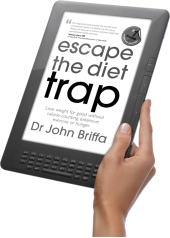I regard myself as quite an active person, but the intensity or volume of the exercise I take is nothing like it once was. For extended spells during my childhood and early adulthood I was a ‘keen’ runner. I participated in athletics and cross-country running at school, and continued running afterwards too. At some points, I was running upwards of 40 miles a week, and I would compete in 10 km and half-marathon races. I genuinely felt I was ‘born to run’. However, while I got a lot of personal satisfaction from my running, the reality is that I generally dreaded the thought of it.
Running quite hard for up to an hour and a half at a time takes a degree of effort and discipline. Sometimes, a scheduled run would play on my mind until I’d completed it, and I’d invariably be mightily relieved to ‘get it out of the way’. Often, after a run, I would ‘veg out’ and hardly move a muscle for several hours.
If I look back, I realise that my exercise habits were also a bit ‘all or nothing’. I would perhaps spend 6-18 months running regularly, and then have several months of doing nothing (sometimes partially enforced through injury) before resuming my running.
These days, I don’t struggle with my ‘exercise’ in the same way, because the walking, swimming and brief resistance exercise sessions I do are simply not that onerous for me. I’m never left feeling exhausted, either.
The change in my exercise habits and my relationship to physical activity came back to me today, on reading about a study in which the impact of two exercise regimes were tried in a group of men.
In this Danish study, moderately overweight men were instructed to expend either 300 or 600 calories a day (e.g. 30 or 60 minutes a day of running) for 12 weeks.
One of the outcomes measured was weight loss, which was an average of 3.6 and 2.7 kg respectively. In other words, twice the exercise did not appear to translate into improved weight loss.
But, for me, the most interesting element of this study was that a selection of the men were asked about their attitudes to the exercise they were taking and its impact on them.
Those exercising for about an hour a day reported increased fatigue, and generally expressed some negative attitudes to exercise including it being ‘time consuming’. On the other hand, those exercise for about half an hour a day had a generally positive attitude to exercise, and did not find the exercise ‘load’ to be a burden.
What someone feels is a suitable and sustainable amount of exercise will, I think, vary enormously. However, my experience and this study point to the fact that more exercise in not necessarily better. Higher volumes of activity are not just generally harder, but can take more time, and this can create barriers for people and reduce the sustainability of activity.
When talking about these issues with clients, I sometimes like to gauge the sustainability of someone’s exercise habits with this specific question: “Can you imagine doing this when you’re 80.”
I have no issue at all with individual enjoying themselves with, say, mountain biking, rugby, football or triathlons. However, such activities tend to fall away in time, and the risk can be that when they do, someone can go from one extreme to the other. For others, being sedentary is partly the result of believing that exercise has to be long and hard and finding the idea quite daunting.
Sometimes, it can help individuals to establish some sort of exercise routine that is realistic and sustainable. I know I’m not going to set any records with my walking, swimming and home-based resistance exercise sessions. I do suspect, however, that I get a lot of benefit from these activities and will still be doing them should I make it to 80.
References:
1. Gram AS, et al. Compliance with physical exercise: Using a multidisciplinary approach within a dose-dependent exercise study of moderately overweight men. Scandinavian Journal of Public Health epub ahead of print 16 September 2013 [hr]
[box style=”rounded” border=”full”]
Dr John Briffa’s best-selling ESCAPE THE DIET TRAP – lose weight without calorie-counting, extensive exercise or hunger is available in the UK and US
“This magnificent book provides the scientific basis and practical solutions to liberate you from yo-yo dieting and allow you to achieve sustained weight loss and enhanced health with ease.”
William Davis MD – #1 New York Times bestselling author of Wheat Belly
To read some of the dozens of 5-star reviews for this book [button link=”http://www.drbriffa.com/amazon-reviews-for-escape-the-diet-trap/” color=”silver” text=”dark” window=”yes”]click here[/button]
To buy a paperback copy of the book from amazon.co.uk [button link=”http://www.amazon.co.uk/Escape-Diet-Trap-John-Briffa/dp/0007447760/ref=tmm_pap_title_0?ie=UTF8&qid=1324815918&sr=1-1″ color=”orange” window=”yes”]click here[/button]
To buy a kindle version of the book from amazon.co.uk [button link=”http://www.amazon.co.uk/Escape-the-Diet-Trap-ebook/dp/B005ODY0RW/ref=tmm_kin_title_0?ie=UTF8&qid=1324815918&sr=1-1″ color=”orange” window=”yes”]click here[/button]

To buy a print copy of the book from amazon.com [button link=”http://www.amazon.com/Escape-Diet-Trap-calorie-counting-extensive/dp/0957581602/” color=”orange” window=”yes”]click here[/button]

To buy the kindle version of the book from amazon.com [button link=”http://www.amazon.com/dp/B00BLQ40QM” color=”orange” window=”yes”]click here[/button]
[/box]